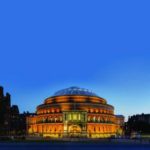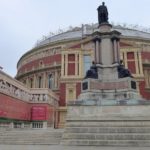 This monument records the success of the Great Exhibition, the international exhibition held in Hyde Park in 1851 organised by Henry Cole and Prince Albert. The success of the 1851 exhibition paid for the construction of not only the Royal Albert Hall, but South Kensington’s entire cultural quarter, known as Albertopolis.
This monument records the success of the Great Exhibition, the international exhibition held in Hyde Park in 1851 organised by Henry Cole and Prince Albert. The success of the 1851 exhibition paid for the construction of not only the Royal Albert Hall, but South Kensington’s entire cultural quarter, known as Albertopolis.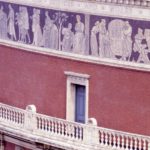 One of the most striking features of the Hall is 800 feet long and depicts the advancement of the Arts and Sciences of all nations through 16 different allegorical groups. It was originally meant to be sculpted in stone, but by the time it was proposed, time and money for the building of the Hall were running low, so it was decided to be created as a flat mosaic. The final materials were suggested by Henry Cole. Cole was keen to use new and innovative materials and he suggested terracotta mosaic as it was easy to clean, durable and suited to the modern building techniques used on the Hall. It reads:
One of the most striking features of the Hall is 800 feet long and depicts the advancement of the Arts and Sciences of all nations through 16 different allegorical groups. It was originally meant to be sculpted in stone, but by the time it was proposed, time and money for the building of the Hall were running low, so it was decided to be created as a flat mosaic. The final materials were suggested by Henry Cole. Cole was keen to use new and innovative materials and he suggested terracotta mosaic as it was easy to clean, durable and suited to the modern building techniques used on the Hall. It reads:
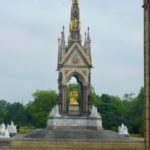 Standing at Door 6, it is hard to miss the huge gold monument over the road in Hyde Park. Door 6 is the historic royal entrance to the Hall. On 29 March 1871, Queen Victoria entered the building through this arched entrance to officially open the Royal Albert Hall of Arts and Sciences. This Hall was originally going to be called the ‘Central Hall of Arts and Sciences’ but, after Prince Albert sadly died before seeing its construction fully realised, it was renamed by Queen Victoria the ‘Royal Albert Hall’, in honour of the man who envisioned it.
Standing at Door 6, it is hard to miss the huge gold monument over the road in Hyde Park. Door 6 is the historic royal entrance to the Hall. On 29 March 1871, Queen Victoria entered the building through this arched entrance to officially open the Royal Albert Hall of Arts and Sciences. This Hall was originally going to be called the ‘Central Hall of Arts and Sciences’ but, after Prince Albert sadly died before seeing its construction fully realised, it was renamed by Queen Victoria the ‘Royal Albert Hall’, in honour of the man who envisioned it.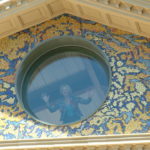 Royal Albert Hall had commissioned artist Shelagh Wakely for this project, who worked with mosaicist Trevor Caley to complete her design in 2003. IT symbolizes every kind of musical sound bursting from the round window which it surrounds. It shows this music meeting outdoor sounds and swirling water, based on the Mandelbrot set and the Julia set – part of chaos theory and the fractal geometry of nature.
Royal Albert Hall had commissioned artist Shelagh Wakely for this project, who worked with mosaicist Trevor Caley to complete her design in 2003. IT symbolizes every kind of musical sound bursting from the round window which it surrounds. It shows this music meeting outdoor sounds and swirling water, based on the Mandelbrot set and the Julia set – part of chaos theory and the fractal geometry of nature.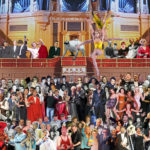 A spectacular 10ft triptych by pop art legend Sir Peter Blake, IT is a montage of stars featuring everyone from music legends Bob Dylan, David Bowie and Jimi Hendrix to pivotal figures in the arts and sciences such as Albert Einstein, Stephen Hawking and J. K. Rowling.
A spectacular 10ft triptych by pop art legend Sir Peter Blake, IT is a montage of stars featuring everyone from music legends Bob Dylan, David Bowie and Jimi Hendrix to pivotal figures in the arts and sciences such as Albert Einstein, Stephen Hawking and J. K. Rowling.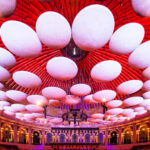 Before acoustic tests were carried out in the late 1960s, the Hall suffered badly from echoing caused by the cove of its ceiling. The arrangement of THESE fibre-glass dishes improves the quality and immediacy of sound for audience members all around the auditorium.
Before acoustic tests were carried out in the late 1960s, the Hall suffered badly from echoing caused by the cove of its ceiling. The arrangement of THESE fibre-glass dishes improves the quality and immediacy of sound for audience members all around the auditorium.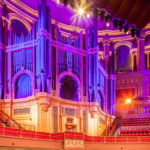 IT was designed and built by Henry Willis at a cost of approximately £8,000. IT was built in just 14 months – a swift construction considering the size of the instrument. IT was moved to the Hall in time to be played at the venue’s Opening Ceremony on 29 March 1871. IT has been played by notable composers and organists such as Anton Bruckner, Charles-Marie Widor, Camille Saint-Saens, George Thalben-Ball, Dr Stephen Cleobury and Dame Gillian Weir.
IT was designed and built by Henry Willis at a cost of approximately £8,000. IT was built in just 14 months – a swift construction considering the size of the instrument. IT was moved to the Hall in time to be played at the venue’s Opening Ceremony on 29 March 1871. IT has been played by notable composers and organists such as Anton Bruckner, Charles-Marie Widor, Camille Saint-Saens, George Thalben-Ball, Dr Stephen Cleobury and Dame Gillian Weir.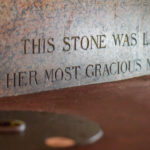 IT is a red Aberdeen granite stone laid by Queen Victoria at a special ceremony on 20 May 1867. Over 7,000 people gathered under a huge temporary marquee as Her Majesty used a golden trowel to lay the stone, as well as a glass ‘time-capsule’ underneath it containing an inscription and a collection of gold and silver coins. Nearly 150 years later IT is still in place, partially visible underneath a seat in Stalls K.
IT is a red Aberdeen granite stone laid by Queen Victoria at a special ceremony on 20 May 1867. Over 7,000 people gathered under a huge temporary marquee as Her Majesty used a golden trowel to lay the stone, as well as a glass ‘time-capsule’ underneath it containing an inscription and a collection of gold and silver coins. Nearly 150 years later IT is still in place, partially visible underneath a seat in Stalls K. 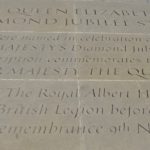 These steps located on the south side of the Hall are situated on the former position of the South Kensington Royal Horticultural Society garden’s conservatory, which provided refreshments and facilities to the Hall’s visitors in the nineteenth century. The conservatory and gardens were demolished in 1889 and a road was built to encircle the Hall, with the South Steps, as they were known, leading down to Prince Consort Road. The steps as they are seen today were formed during the Hall’s redevelopment project carried out between 1998 and 2004.
These steps located on the south side of the Hall are situated on the former position of the South Kensington Royal Horticultural Society garden’s conservatory, which provided refreshments and facilities to the Hall’s visitors in the nineteenth century. The conservatory and gardens were demolished in 1889 and a road was built to encircle the Hall, with the South Steps, as they were known, leading down to Prince Consort Road. The steps as they are seen today were formed during the Hall’s redevelopment project carried out between 1998 and 2004.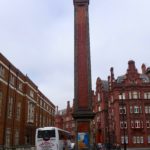 The brick structure was designed by Major-General Scott RE, the main architect of the Royal Albert Hall, and remained in place after the Royal Horticultural Society conservatory was demolished in 1889. IT is still in use today and sits above the steam boilers which heat the Hall. IT is regularly maintained and inspected and has been repointed when necessary. Metal bands have been added to give the structure extra strength.
The brick structure was designed by Major-General Scott RE, the main architect of the Royal Albert Hall, and remained in place after the Royal Horticultural Society conservatory was demolished in 1889. IT is still in use today and sits above the steam boilers which heat the Hall. IT is regularly maintained and inspected and has been repointed when necessary. Metal bands have been added to give the structure extra strength.
Did you know that although the South Porch at Door 12 may look identical to the others, it is much newer and only opened in 2004?
This Hall was erected for the advancement of the Arts & Sciences and works of industry of all nations in fulfilment of the intention of Albert Prince Consort. The site was purchased with the proceeds of the Great Exhibition of the year MDCCCLI. The first stone of the Hall was laid by Her Majesty Queen Victoria on the twentieth day of May MDCCCLXVII and it was opened by her Majesty the twenty ninth of March in the year MDCCCLXXI. Thine O Lord is the greatness and the power and the glory and the victory and the majesty for all that is in the heaven and in the earth is thine. The wise and their works are in the hand of God. Glory be to God on high and on Earth peace.
Can you estimate how many red bricks and blocks of terracotta were used to build the Hall’s exterior?
How many stars do you think are depicted in this triptych?
Can you estimate how many acoustic diffusers hang from the auditorium ceiling?
Can you guess its size and weight?
If laid end to end, how many miles do you think its pipes would span?
On 9 November 2013, ahead of the Royal British Legion’s Festival of Remembrance, the Hall’s Patron HM Queen Elizabeth II and HRH The Duke of Edinburgh attended a ceremony to rename the steps the Queen Elizabeth II Diamond Jubilee Steps.
A stone plaque to mark the occasion was placed towards the bottom of the steps.
ANSWERS
- MEMORIAL FOR THE EXHIBITION OF 1851
- MOSAIC FRIEZE
- ALBERT MEMORIAL
- MOSAIC TYMPANUM
- ‘Appearing at the Royal Albert Hall’
- THE MUSHROOMS
- Henry Willis Organ
- Foundation stone
- Queen Elizabeth II Diamond Jubilee Steps
- Chimney
Opposite the Hall’s south entrance (Door 12) on the Queen Elizabeth II Diamond Jubilee Steps.
The mosaic frieze that encircles the Royal Albert Hall is 800ft long and 5,200sq.ft.
The building’s distinctive exterior is built from over 6 million red bricks and 80,000 blocks of terracotta.
Located in Kensington Gardens on Albert Memorial Road opposite the Royal Albert Hall. It is one of London’s most ornate monuments, designed by George Gilbert Scott.
Decorative piece adorning the South Porch, designed by Shelagh Wakely.
Explore the piece, currently on display in the Hall’s Door 12 entrance.
It depicts more than 400 stars!
The 85 fibreglass saucers which hang from the auditorium ceiling are acoustic diffusers affectionally known as mushrooms.
Described as ‘the voice of Jupiter’, the Hall’s organ was once the largest instrument in the world. Today the largest of the 9,999 pipes measures 2 ft 6” in diameter, 42 ft high and weighs almost 1 tonne – the smallest pipe is about as wide as a drinking straw. It measures 70 ft high and 65 ft wide, and weighs in at 150 tonnes. If laid end to end, the pipes would span approximately nine miles.
The Hall’s granite foundation stone, laid by Queen Victoria in 1867. Take a look under row 11, seat 87 next time you’re at the Hall!
Formerly known as the South Steps; located on the south side of the Hall.
The Grade I listed structure neighboring the Hall.
REFERENCES
- Explore the Hall’s iconic frieze
- From the Archives: Acoustic Mushrooms and the Royal Albert Hall Echo, 1969
- From the Archives: meet Albert the organ cat
- Prince Albert’s cultural vision and the history of South Kensington: Albertopolis
- Royal Albert Hall – ALL THINGS VICTORIAN
- ROYAL ALBERT HALL: BUILDING | TIME MACHINE
- Time capsule buried by Queen Victoria uncovered during Royal Albert Hall dig
- Visiting the Hall? Don’t miss these 6 iconic features
- Why was the Royal Albert Hall built?
Royal Albert Hall will turn 150 years in 2021 and we just added The Proms to our young wish list this year after a grand tour of the Hall… looking forward to IT!

